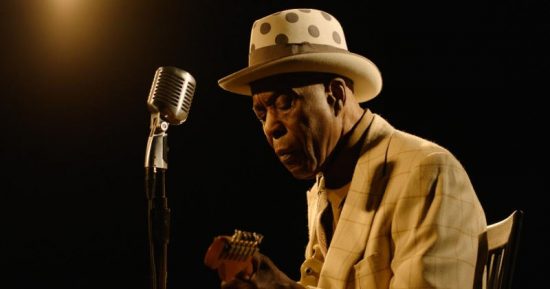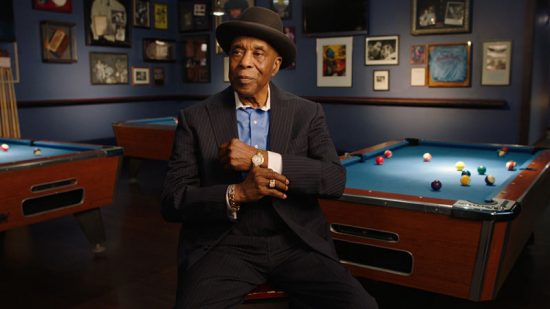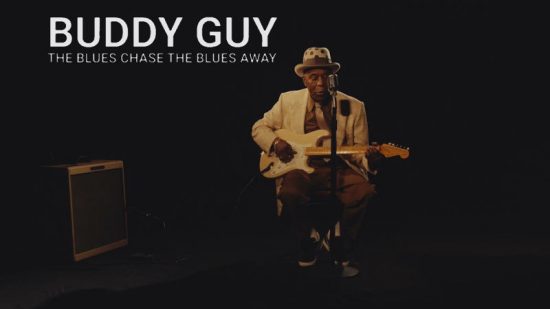EIFF Review – Buddy Guy: The Blues Chase the Blues Away
Directed by Devin Chanda, Matt Mitchener, Charles Todd
Chanda, Mitchener and Todd’s excellent documentary one arguably the greatest living Blues legend, George “Buddy” Guy, opens, appropriately enough with Buddy himself revisiting Lettsworth, Louisiana, where he was born way back in 1936. Like the great Johnny Cash, his parents were poor share-croppers, and he grew up picking cotton by hand, slowly being introduced to music as he grew up, through friends and relatives bringing over instruments to play at get-togethers, or when they finally got hold of a record player; he knew when he heard the music that he wanted to make his own, but of course he could have no idea that it would ever become a lifelong career, let alone one so long, successful and influential. As the now eighty-something Buddy looks back over those fields where he grew up, we’re taken back along his long journey.
Working whatever low-paying jobs he could get after leaving home for Baton Rouge, he continued to practice his guitar and soon was noticed, picking up some work with bands in the city, but eventually, he moved to the Windy City, Chicago, in 1957, one of the great spiritual homes of Blues music. As Buddy tells it to the camera, back then the city was teeming with Blues bars, many of them free to enter – only drinks cover charge – making them accessible to pretty much anyone, an absolute feast of live music, right place, right time, and its here he came to the attention of Blues God Muddy Waters, as well as, eventually, the famous Chess Records label, although as he and others note, although Chess used him in recording sessions with others, they refused to record him doing his own now unique style.
As Buddy recalls with a laugh, most Blues players would play sitting down, but he stood up, moved about energetically, bent the guitar strings about as far as they can go without breaking to create interesting, new sounds, wasn’t afraid of some feedback, he could be a wild man with a guitar and a song when playing live. It’s not hard to be reminded of Jimi Hendrix in this regard. But Chess just didn’t get it, and while Buddy stuck to his work ethic of plugging in and playing pretty much every night, outside of a small circle he wasn’t getting the wider attention because they wouldn’t record him playing in that live style.
As the turbulent 60s rolled on and then the 70s, his influence was still getting out there to a select few though – among them new talent from across the Pond, in Britain, people like Mike Jagger, Keith Richards, Eric Clapton and more, and these increasingly famous musicians were very open about their Blues influences and how it fed into their rock’n’roll style, and about musicians like Buddy, or Howling Wolf, Muddy Waters or John Lee Hooker, paying their respects to the people who inspired and influenced them. And of course they mentioned them when they came to perform in the US, incredulous that so many into music didn’t know of these creators right on their own doorstep, and naturally this got a lot of youngsters thinking, who are these guys Clapton and Richards are talking about and how do I hear their music?
That theme of inspiration and legacy is key to much of this documentary – just as these now global stars like the Stones paid tribute to Buddy (there are some wonderful scenes of them jamming in his club in the early 70s, and Buddy and Guy playing around each other on stage decades later, the looks of pure joy on their faces is a delight, it’s not rock stars, it’s just mates making music together), Buddy takes great care to pay very sincere respect to his inspirations, and the pleasure on his face even now in his 80s as he talks about meeting John Lee Hooker – whose music he used to practice to as a youngster – just shows unvarnished joy. That legacy is also paid forward, not just backwards, with new, young musicians who have grown up and carrying on the Blues tradition, in their own styles but all influenced by Buddy’s playing, and he is clearly delighted – the legacy he inherited from the players before him, all now gone, is passed on, even when he’s no longer here the Blues will live on.
The film is beautifully crafted – the directors talked after the film (via Zoom, in-person appearances and travel not very easy at this year’s festival, as you can imagine) about how they had to rethink some of the filming because after the planning stage, Covid hit, and everything had to change from their original idea of following Buddy on tour (until Covid, despite his age, Buddy still did around 130 gigs a year around the world). They talked about being able to get hold of people like Clapton and Santanna to talk about Buddy’s influence on their playing when they started out, about the struggle to find archive footage and photographs. Later stuff is a little easier, with recordings, photos, even footage, but early images, well, nobody had a camera documenting their life as rural share-croppers in the 30s, so they turned to a painter they’d seen in a leaflet Buddy himself had in his house, Earl Klatzel, who had covered that period, and his imagery fitted in perfectly to their Covid-revamped filming plan.
This is a wonderful documentary, going through the good times and the rough, but mostly it is joyful, celebrating the work of a musical legend, and the enormous influence his work has had on so many other performers. Even if you’re not a Blues fan, there’s a big chance some of your favourite musicians have been inspired by Buddy’s work, he’s a musician’s musician. And if you are a Blues fan, then this is Blues heaven for you, an amazing life story and a banquet of fantastic music. This is the sort of music documentary that makes you want to go home and spin some of your favourite vinyl for hours. And the film circles around nicely, back to that opening of Buddy as he is now, back looking at the fields where he grew up in the 30s, but he’s here not just for nostalgia, or for the documentary, but because they are naming the nearby road after him, complete with historical plaque, giving him his dues as a local lad done good.
And that title: well, that’s Buddy. As he explains in the film, you can’t just sing the Blues, you have to have lived the life and have it inside your soul; you have to have the Blues, not just play it. Funny thing is, he comments with a big grin, is that when you’re playing it, the Blues go away and you feel better: the Blues chase the Blues away…












